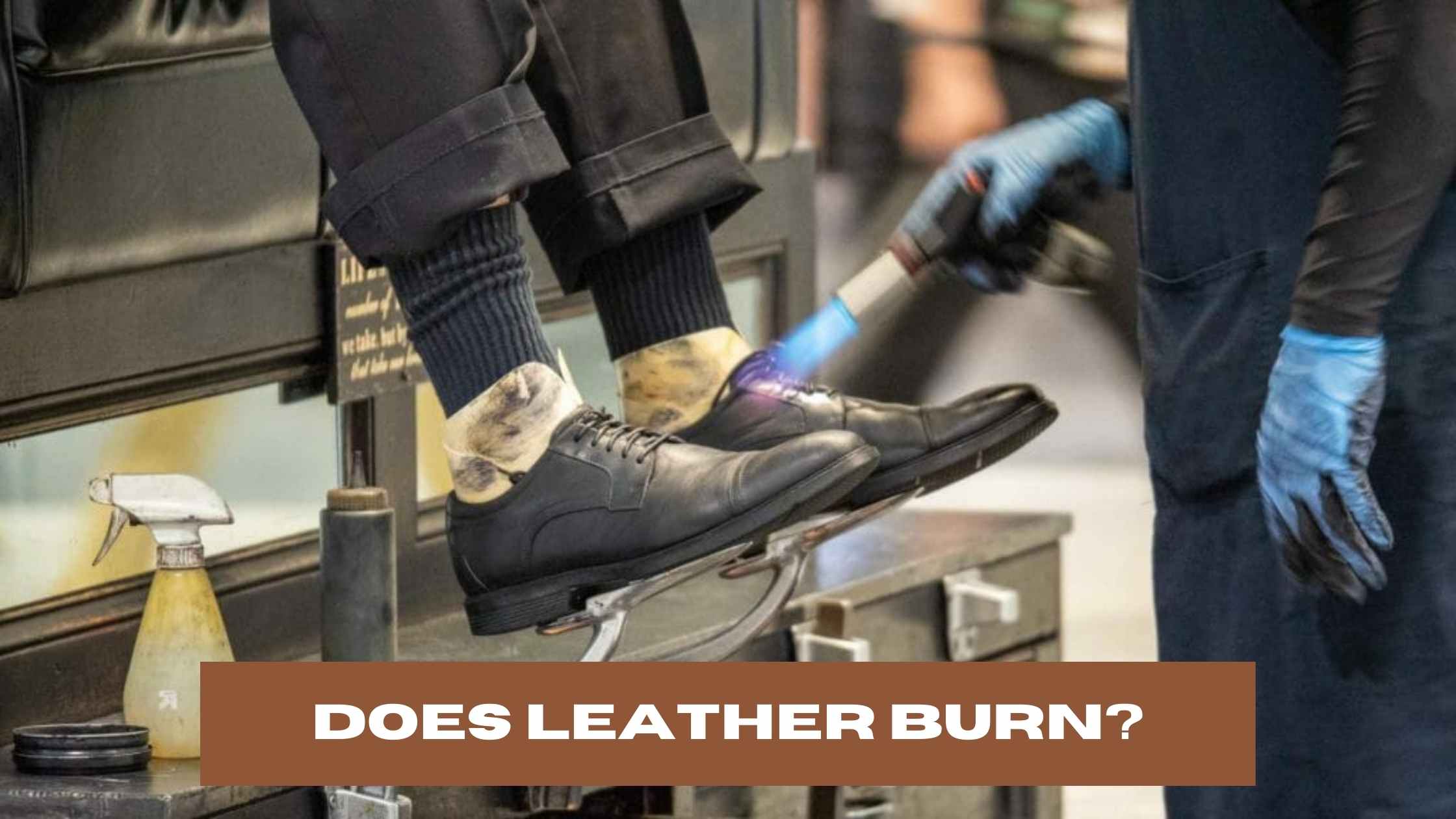If you’re reading up on leather, you may have heard curious stories about leather’s strange reaction to fire. But does leather burn? Here’s what you’ll want to know about it for your leather’s protection.
Leather can technically burn, but it can’t melt. Leather has a strong natural resistance to burning, so it won’t simply burst into flames when you get a match too close. When leather does start to burn, it’ll char and then shrivel rather than burn directly.
Surprisingly, there’s much to know about leather and its relationship to fire! I’ve gone over the basics below for you.
Key Takeaways:
- Leather’s Reaction to Fire: Leather can burn, but it cannot melt. It has a strong natural resistance to burning, and when it burns, it chars and shrivels rather than directly bursting into flames.
- Fire Resistance of Genuine Leather: Genuine leather is naturally fire-resistant due to its composition and treatment. It shares similarities with human skin in its resistance to burning. When exposed to fire, it may char, shrink, and shrivel.
- Burning Temperature: Leather can start to burn at temperatures hotter than 392°F (200°C). The quality and care of the leather determine its flashpoint, with higher-quality leather requiring higher temperatures to catch fire.
- Leather’s Tolerance to Fire: Leather will shrivel and shrink at temperatures below 390.2°F (199°C) rather than burn. Once the shriveling process begins, its flashpoint is not far off. Attempting to fix shriveled leather is not recommended.
- Burning Duration: Leather can start to burn after around 10 seconds of consistent, close exposure to the appropriate temperature. Some leather may take longer, but most won’t ignite faster.
- Pores and Moisture: Leather’s ability to resist burning is due to its pores, which absorb and retain moisture. The moisture protects the leather from flames, preventing it from burning easily.
- Burning Fake Leather: Unlike genuine leather, synthetic leather (faux leather) can melt or catch fire, depending on the processing and flame temperature. Burning fake leather releases toxic chemicals such as carbon monoxide.
Is leather naturally fire-resistant?
Since genuine leather is made from animal skin and treated using chemicals, it will naturally be fire-resistant. Animal skin, like human skin, naturally has a very strong resistance to burning. This works in your favor since you won’t want your leather to go up in flames with no time for you to deal with it.
As mentioned above, you’ll smell burning hair, and the leather will shrink and shrivel up before curling into a charred mess of animal skin if it’s left long enough.
Does leather burn or melt in a fire?
Let’s take an example of your house is on fire and your leather jacket or backpack being caught in flames. Will they burn or melt? Natural leather won’t melt (more on that later), and the most likely result is that your leather will char and shrivel if it gets hot enough in the fire.
At what temperature does leather burn?
Fires can burn at different temperatures, of course, and the same goes for using something handheld like a lighter or a match and holding it to your leather jacket. As Fire Safe Living explains, leather can start to burn in fires hotter than 392 degrees F (200 degrees C).
Fun Fact: Your leather’s quality and care will determine its flashpoint. The higher the quality, the higher the temperature has to be for it to catch. It will also take longer for your leather to catch fire in the first place.
What temperature can leather withstand?
So, now that you know leather can burn at 392 degrees F (200 degrees C), you’re probably curious about what leather can withstand when it comes to fire. Anything less than 390.2 degrees F (199 degrees C), you can expect your leather to shrivel and shrink rather than burn. This shriveling is the first stage of its breaking down.
Once you start to see the shriveling process, you can expect its flashpoint to come soon after. Also, leather that begins to shrivel can’t be fixed, so don’t try this experiment at home!
How long does it take for leather to burn?
Generally, leather can burn anywhere after 10 seconds of consistent, close exposure to the temperature mentioned above. Some leather may take longer to start to burn, but most won’t take less.
Why doesn’t leather burn easily?
If leather is treated with so many chemicals and it’s such a sensitive material as far as exposure to the elements. Then, why doesn’t it burn in a second or two of exposure to a flame?
It’s all about pores. Since your leather is authentic animal skin, it has pores like human skin. Those pores will absorb moisture and retain it. When you expose leather to fire, the moisture protects the leather very well. Because of this moisture, your leather won’t just burn to ashes.
What happens when leather burns?
The actual process of leather burning is this: shriveling, shrinkage, edge curling, and then finally, charring and burning. While it’s tempting to believe that leather is totally fireproof, this is unfortunately not the case. You can ruin your leather if you expose it to flames!
Fun Fact: Deliberately burning leather is an art form called pyrography, and it’s used to create beautiful images in this natural material.
Does leather smell when burnt?
Leather does have a smell as it is burnt, and it’ll be similar to burnt hair. Like when you were a child, and a piece of your hair fell on a heater or a stovetop burner, it’ll start mild and then get stronger as the burning continues.
Is burning leather toxic?
Unlike a simple burning hair in the example above, burning leather isn’t going to be harmless to your health. Because of its processing through the tanning period and your own care of leather, it is toxic to burn. Benzene, chlorobenzene, and hydrogen cyanide are just some of the few chemicals that are released as leather burns.
Does burning leather prove it’s real?
Yes, holding a lighter to a leather item can tell you quickly if it’s real or not! This is a trick that leather experts and smart shoppers alike will use when considering buying a leather item from someone.
To inexperienced people, it sounds absolutely crazy to hold a lighter to something that you haven’t paid for, but it’s standard practice in the leather industry.
This is so common that it’s almost expected if you’re considering a purchase. It’s acceptable to ask permission from the seller of the leather item to use a lighter on it. While you should always ask first, any leather professional will have no issue with you holding a lighter or a match to the leather you’re considering.
If the seller does get antsy or refuses outright, there could be two potential issues. The first is that they aren’t educated enough in leather to understand that this is harmless to leather. The second is that the leather you’re considering purchasing isn’t real! Both of these should warn you away from going through with the sale!
Reasons for leather to burn easily
There are exceptions to every situation, as you well know. One of them could be that your leather does actually burn easily — much to your dismay. This is one of the reasons why you should never try to burn your leather item at home! If this is the reality that you’re dealing with, there are two leading causes of this:
- Your leather has plastic in it
- Your leather is in very poor condition
Not all leather is going to be authentic and pure anymore. A combination of plastic and genuine leather is becoming more common in leather goods since PU leather looks realistic and blends in easily with natural leather. As I’ll talk about in a bit, PU leather doesn’t have the same fire resistance.
Also, old and poorly cared-for leather can catch on fire easily because it lacks the moisture or tensile strength it would have if it was properly cared for. The older your leather gets, the more dried out it can get.
Can you melt leather together?
You can’t melt leather together, no. Since leather doesn’t melt, the pieces you are trying to melt together will simply shrivel and char up into individual burnt pieces of leather!
Does fake leather burn or melt?
While authentic leather won’t melt, fake leather will! Mission Mercantile explains that synthetic leather can either melt or catch fire, depending on processing and the temperature of the flame that is being held to it.
Is burning faux leather toxic?
In this case, burning synthetic leather will be even more toxic than burning authentic leather. Burning/melting PU or PVC (two key ingredients in fake leather) releases carbon monoxide, amongst other chemicals.
Hint: If you’re ever burning real or fake leather, for whatever reason, make sure that you wear proper safety gear to protect your lungs and general health!
FAQ: Is Leather Fire Resistant?
Is leather flammable?
Leather is generally considered to be flammable. It can catch fire when exposed to high temperatures or an open flame.
Can leather burn or melt?
Leather can burn when exposed to a flame or high heat. It does not melt like synthetic materials.
Is genuine leather more flammable than faux leather?
Genuine leather is generally more flammable than faux leather. Faux leather is often treated with flame retardant chemicals to make it less likely to catch fire.
What is flame retardant leather?
Flame retardant leather is leather that has been treated with chemicals to make it resistant to ignition and slow down the spread of fire.
Is all leather flame retardant?
Not all leather is flame retardant. Some types of leather may have natural flame resistance, but others may require treatment to become flame retardant.
Are leather products like couches flame resistant?
It depends on the specific leather product and its manufacturing process. Some leather products, especially those designed for fire safety, may have flame-resistant properties.
Can leather be made fire resistant?
Leather can be treated with flame retardant chemicals to make it more fire resistant. However, the level of fire resistance may vary depending on the type and quality of the leather.
Is leather considered fire retardant?
Leather can be considered fire retardant if it has been treated to meet fire protection standards. However, it is important to check the specific fire safety rating of the leather product.
What are some common fire prevention measures for leather?
To prevent fire accidents involving leather, it is recommended to keep leather away from open flames, high heat sources, and to follow proper fire safety guidelines.
Are all leather types equally flammable?
No, not all leather types are equally flammable. The flammability of leather can vary depending on factors such as the tanning process, type of leather, and any flame retardant treatments applied to the leather.
Leather is a pretty impressive material when you think about it from this point of view. While it technically can burn, its flashpoint is very high, and proper care can provide it with a natural fire resistance of up to 392 degrees F (200 degrees C).
Authentic leather will shrivel, shrink, and char when exposed to enough flame, but it will never melt. Synthetic leather can melt or burn, depending a lot on the chemicals used during its production.
Know someone who will find this fascinating? Share this tidbit of information with them and wait to see what their reaction is!

